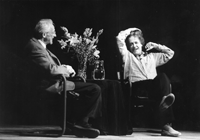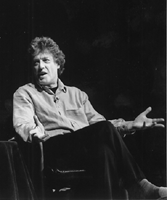Math Program Plays to Packed House
April 22, 1999

The Professor and the Playwright---clearly enjoying themselves in a far-ranging conversation before a rapt audience, Robert Osserman and Tom Stoppard traded insights on mathematical ideas from turbulence to number theory, on mathematics as metaphor, and on the view that writing a play can be something like writing a very "elegant equation."
This February, SIAM News was again approached about Arcadia, again by a former SIAM president. A long-time, devoted Stoppard fan, Margaret Wright was understandably enthusiastic about an upcoming special event at the Mathematical Sciences Research Institute in Berkeley: "Mathematics in Arcadia," billed as a conversation between Stoppard and MSRI special projects director Robert Osserman, with scenes from Arcadia to be performed by students from the Center for Theater Arts at Berkeley.
As in Stoppard's play, a number of varied strands seemed to be converging in this event, which promised to have something to say not only about the mathematical ideas themselves (chaos theory, thermodynamics, Fermat's last theorem, iterative algorithms), but also mathematics in art, appreciation for mathematics among the general population, and MSRI itself.
The Setting
The Mathematical Sciences Research Institute is one of two major institutes created by the National Science Foundation's Division of Mathematical Sciences in 1980 (the other is the Institute for Mathematics and Its Applications at the University of Minnesota). Both MSRI and IMA, with their NSF awards scheduled to run out in 2000, recently took part in a recompetition for funding; the competition was open to other institutions as well, and DMS director Donald J. Lewis let it be known that the division might be interested in creating more than two institutes. Official announcement of the decisions is expected in May.
David Eisenbud, who became director of MSRI in 1997 (just in time to write the proposal for continued funding), considers outreach an important part of the institute's activities. He was therefore receptive to the idea of an "Arcadia event," suggested and later designed and planned by Osserman and David Hoffman, also of MSRI, after a San Francisco performance of Arcadia. The event was supported in part by the Alfred P. Sloan Foundation.
Key Players
Tom Stoppard: English playwright whose first hit was Rosencrantz and Guildenstern Are Dead (1967) and subsequently the author of Hapgood, Travesties, Jumpers, Arcadia, and Indian Ink, among many others; winner of an Academy Award this year as co-author of the screenplay for Shakespeare in Love. In San Francisco for the American premiere of Indian Ink, Stoppard had agreed to an MSRI request that he participate in a discussion of Arcadia during his stay.
Robert Osserman: Professor emeritus of mathematics at Stanford University, former deputy director of MSRI, author of the 1996 book Poetry of the Universe, and author of the letter responsible for Stoppard's participation in the event. During the event, as he explained to the audience, he would be interviewing Stoppard and performing the function of Indian Ink's Eldon Pike-that is, providing footnotes to the story as it unfolded.
Four Berkeley theater students, undergraduate and graduate, playing the roles of the two main characters in each of Arcadia's time periods (1809-1812 and the present day):
Thomasina Coverly: Mathematics prodigy, 13 years old in 1809, when the play opens.
Septimus: Thomasina's tutor.
Hannah Jarvis: Present-day writer, researching a book about 19th-century landscape and literature.
Valentine Coverly: Present-day postdoc in mathematical biology.
The Action
On the stage of a completely sold-out auditorium, Stoppard and Osserman are seated at a small table. Stoppard, SIAM News learns, has expressed some last-minute trepidation, wanting to make it clear that, despite the prominence of chaos theory in Arcadia (and of quantum mechanics in the earlier Hapgood), he doesn't know any mathematics. He has been given only a sketchy description of the event and is not aware even of what scenes the actors will be performing. Osserman, for his part, hasn't planned the interview in any detail (he confides afterward that he had considered explaining the heat equation in the course of the conversation but had been talked out of it). What he brings to the event is an intense admiration for and, as quickly becomes clear, impressive familiarity with Stoppard's plays.
Over the next hour and a half, the four student actors, sharing the stage with Stoppard and Osserman, perform four scenes from the play, selected for being the play's most mathematical. Before and after each scene, Stoppard and Osserman really do engage in conversation-unplanned and spontaneous enough to be interesting, but for the most part coherent, rapid, and, often, witty (on both sides).
The first scene performed is the play's opening scene. A very funny scene, it ends with Septimus's statement of Fermat's last theorem, a proof of which is to be Thomasina's assignment for the evening.
"That has to be the all-time greatest introduction to a mathematical theorem," Osserman says, before launching into the first of his "footnotes": As of 1809, he explains, only two cases of the theorem had been settled: Fermat himself had given a proof of his famous conjecture for fourth powers, and a century later, Euler proved it for cubes; by 1993, when Arcadia was first performed in London, Joe Buhler and his co-workers had done a computer proof showing that Fermat was right for all powers up to 4 million. Two months after Arcadia opened, Wiles announced his proof, having worked on it in secret for many years.

Intrigued by the idea that numbers can describe so many aspects of the natural world, Tom Stoppard created in Arcadia's 19th-century mathematical prodigy Thomasina a character whose enthusiasm for her ideas is conveyed in remarkably clear explanations of, for example, work being done today in dynamical systems.
"Did you have any idea that Wiles was on to this?" Osserman asks.
"No," Stoppard replies, adding that after the news broke they were inserting copies of the front-page story from The Times into the program (and thinking of withdrawing it when news of the gap in the proof emerged).
How, then, Osserman wants to know, did Stoppard become aware of Fermat's last theorem.
"Probably like a lot of people," Stoppard replies, "I have quite an appetite" for information about math, which I take in "at the level of an airport paperback." Given his "fascination for the discipline," he likes talking to people about it (entirely believable to the Berkeley audience).
"I find math deeply potent on some level," Stoppard says, immediately clarifying: Just as earlier, quantum mechanics had struck him as "an extremely potent metaphor for something," he had stumbled onto a good journalistic book about chaos theory and wanted to write a play that would use the mathematics without making it look gratuitous. The difficulty for the writer, he explains, in the patient manner mathematicians adopt in explaining mathematical ideas to nonmathematicians, lies in establishing a differentiation between "exposition of material" and use of it in "an organic way."

Especially gratifying, says Robert Osserman, were the "math-phobic types who came because of Stoppard but with great trepidation about the math angle and discovered that they enjoyed the whole thing."
Like O'Malley in his SIAM News review, Osserman is interested in possible models for Thomasina. Prodigies in math are usually boys, he says. "Did you have a model?"
"No," Stoppard replies, "and it wasn't Byron's daughter" (laying to rest O'Malley's hypothesis). Nonetheless, Stoppard has set Osserman up for another footnote, and the audience learns a bit about Ada, Byron's only legitimate daughter, as well as another possibility, the early-19th-century mathematician Sophie Germain (whose work in number theory would turn out to apply to Fermat's last theorem-and of whom Stoppard was unaware when he wrote the play).
Stoppard clearly finds possible antecedents for Thomasina less interesting than the problem of portraying a genius in art. What makes Thomasina an appealing character, he tells the audience, is that in every respect but the mathematics, she is a perfectly ordinary young woman. (Mathematicians, too, find the character appealing-a welcome departure from the weird, eccentric mathematicians often portrayed in plays and movies, Thomasina is a charming character, visibly excited about what she's found, and with some great lines to explain her ideas.) As to the social significance of the character, Stoppard simply thought that in 1809, it would have been unusual and therefore interesting to have a girl being tutored in math.
The three additional scenes are performed, leading Stoppard and Osserman into discussions of other mathematical ideas in the play.
"God's truth, Septimus," Thomasina says in one of the scenes, "if there is an equation for a curve like a bell, there must be an equation for one like a bluebell, and if a bluebell, why not a rose? Do we believe nature is written in numbers?"
Digressing for a moment at the conclusion of this scene, Osserman explains that Newton was a rare individual, at the top in both physics and math, working in the area between---his laws of motion and of gravity---and deriving Kepler's laws as a consequence. Laplace was probably most famous for writing a book about the ability to describe the entire solar system; he carried Newtonian philosophy to the degree that it seemed as if it would be possible to describe everything. Was Stoppard thinking of Laplace's famous description of the deterministic universe when he had Thomasina suggesting an equation for the future, describing every atom in the universe?
Thomasina, Stoppard says, "got there just before Laplace."
And did Stoppard know that the bell curve was something Laplace was working on at the time? In this case, Stoppard reveals, the connection with Laplace was mere coincidence.
In a scene very near the end of the play, Thomasina wants to know what Septimus is reading. His answer, "a prize essay of the Scientific Academy in Paris," prompts Osserman to identify the essay as Fourier's work on the heat equation. (Later, circling back to Sophie Germain, he will point out that she and Fourier developed a warm personal relationship and that both, although the authors of prize essays, were outsiders.)
Heat, in more ways than can be touched on here, is a major element of the play. "It concerns your heat engine," Thomasina says, offering Septimus a diagram she's just completed. "Improve it as you will, you can never get out of it what you put in." Somewhat later: "Newton's equations go forwards and backwards, they do not care which way. But the heat equation cares very much, it goes only one way."
"Where did you get this?" Osserman asks.
"Is it true?" Stoppard asks in turn.
"Yes."
"You had me worried for a minute."
Admitting to having "plucked this from somewhere and used it without really understanding it," Stoppard explains that he doesn't really understand the part about heat being irrecoverable, was simply "desperate for a connection between entropy and the second law of thermodynamics."
Did it Work?
The Berkeley event, and of course Stoppard's play, clearly contain far too much hopelessly intertwined material to permit anything but a short report of arbitrarily selected highlights. Like O'Malley, this reporter encourages interested readers to seek out a performance of the play.
For those interested in a model for outreach events: Take a world-class playwright known to be fascinated with mathematics and an articulate, knowledgeable faculty member, willing to get up on stage together for a high-visibility venture into each other's worlds, throw in a freak sunny 75� day in February, and a big audience will learn something about mathematics and leave positively exhilarated, with a new perspective on mathematical ideas.---GRC

